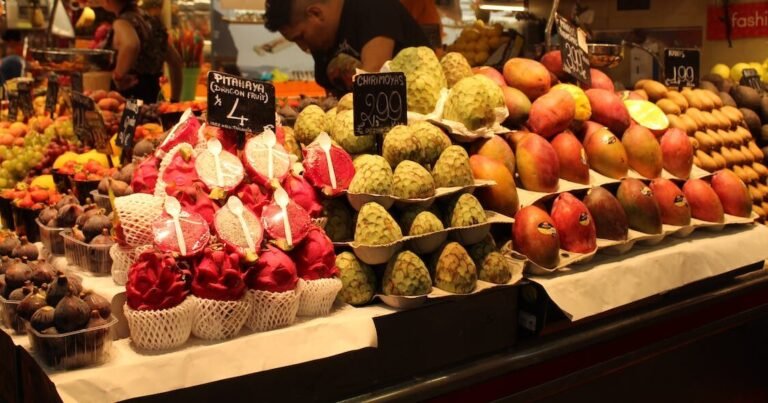We often associate sunny beaches and iconic architectural landmarks with Spain, but it's also worth paying attention to the local cuisine, which is famous for its fresh fruits and vegetables.
Spain is one of the largest producers and exporters of fruit in the world, and each region of the country has its own unique seasonal fruits that are worth trying.
The best time to buy seasonal fruits is when there are many of the same type of fruit on sale, when they are at their tastiest and most affordable. For example, oranges are at their tastiest and most available in winter, but they can also be found in markets in spring and summer. Apricots and peaches are at their tastiest and most available in summer, but they can also be found in markets in spring. The best place to buy fresh fruit is at local markets., where you can find a wide range of seasonal fruits at a good price, not supermarkets.
Peaches (Melocotón)

Seasonality: from late May to early October
Peaches are one of the most popular fruits in Spain. Although Spain values crisp fruit over soft, peaches will still be crisp, but still ripe and sweet.
Avocado (Aguacate)

Seasonality: from November to July
Avocados are a fruit that has become increasingly popular in Spain in recent years. Avocados are high in fat, but these fats are monounsaturated, which helps maintain heart and vascular health. They can be added to salads, made into sauces, or used on their own.
Kiwi

Seasonality: winter
Kiwi is an exotic fruit that appears in markets in Spain in winter.
Kiwis are high in vitamin C, potassium, and many other nutrients. They add a refreshing touch to any salad or dessert. They can also be used to make a delicious juice or smoothie.
Almond (Almendra)

Seasonality: flowering – in February;
Harvesting is August-September.
in stores/markets for sale all year round;
Almonds are not only a fruit, but also a source of healthy fats, proteins and vitamins. In Spain, almonds are added to many dishes, including meat and fish dishes, as well as desserts. They are one of the important components of the so-called "Mediterranean diet", which is actively used in many recipes, and they are also used to make a Christmas treat - "turrón".
Pomegranate (Granada)

Seasonality: from October to early January
Pomegranate is a fruit that has long been popular in Spain. The seeds in fresh pomegranates are soft, easy to chew, and there is no need to peel them. They can be added to salads or used as a garnish for dishes.
Japanese medlar (Nispero japonés)

Seasonality: during April and May
The medlar is a fruit with a delicate, sweet taste and nutritional value. It is consumed as a standalone product or added to salads and desserts. This plant originates from Japan and China, but it also thrives in Spain, thanks to the climatic conditions and the availability of sufficient amounts of excellent quality water.
Cherimoya (Cherimoya)

Seasonality: autumn and spring, not available in the summer months. In the winter months – available, but more expensive, smaller, and worse.
Cherimoya is a fruit that has a strong aroma and a sweet, creamy taste. In Spain it is called “la fruta del conde” (the fruit of the count) because it was only eaten by high-ranking officials of the former colonial empire. Cherimoya has a high nutritional value and is used in the preparation of desserts, drinks and ice cream. Green cone, white flesh and black seeds (the seeds cannot be eaten, they are poisonous inside)
Mandarin (Mandarina)

Seasonality: Winter
Mandarin is a fruit that appears in markets in Spain in winter. It has a thin skin and a sweet, light taste.
Fig (Higo)

Seasonality: from the end of June to the end of August
Figs are a fruit that is considered a symbol of Spain. They have a sweet taste and are rich in nutrients such as vitamin C and potassium. Figs can be eaten on their own, added to salads, or used to make desserts.
Orange (Naranja)

Seasonality: Year-round, but most delicious from fall to early spring.
Oranges are a fruit that appears in the markets of Spain from autumn to spring. They have a bright orange color and a sweet taste. Citrus fruits are one of the significant sources of income (both in exports and in the domestic market of Spain): They are also one of the most exported fruits.
Grapes (Uva)

Seasonality: from August to the end of December
Grapes are a fruit that appears on the markets in Spain in the fall. They come in different sizes and varieties, but they all have a sweet taste and are full of nutrients. The last grapes are picked on the 20th of December, and left on the vine, because it's all about the New Year's tradition: to the beat of the local chimes at the change of year, you have to eat grapes, one berry for each chime, for a total of 12, making a wish for each one.
Persimmon (Kaki)

Seasonality: October – December
Persimmons are a fruit that has a sweet, light taste and many beneficial substances, such as vitamin A and potassium. In Spain, persimmons are usually eaten as a standalone product or added to salads and desserts. Once upon a time, the fruits were sold so tender that the pulp could practically be drunk by biting through the skin, but here crunchy fruits are more valued than soft ones, so persimmons now undergo special processing before being sold, which allows them to maintain this crunchy state for longer. In other words, a hard fruit does not mean “unripe”.
Melon

Seasonality: summer months and early autumn.
Melon is one of the most popular fruits in Spain, with a fresh, sweet taste and soft texture. Melon can be eaten on its own, added to salads and used in desserts. There are at least 3-4 varieties of melon (summer and winter) available in stores and on the market almost all year round, although the summer months and early autumn are considered the season.
Strawberry (Fresa)

Seasonality: from February to May
Strawberries have a sweet taste and are rich in nutrients such as vitamins and antioxidants. They can be eaten on their own, added to salads, or used to make jams and sauces.
Conclusion
Fruits in Spain are not only delicious food, but also part of the culture and tradition. They are associated with festivals celebrated throughout the country, such as the “Fiesta de la Tomatina” (Tomato Fight) in Buñol and the “Fiesta de la Vendimia” (Wine Festival) in La Rioja. If you are in Spain, be sure to try these wonderful fruits and enjoy their flavors and beneficial properties.
In addition, fruit in Spain is also an important component of the country's economy, with grapes and oranges, in particular, being Spain's main export products according to the Ministry of Agriculture.
In general, Spain is a real paradise for fruit and berry lovers. Here you can find many varieties and types of fruits that are not only high in nutritional value, but also very tasty and aromatic. So, if you want to enjoy the taste of the best fruits in the world, you should try Spanish fruits and berries.

